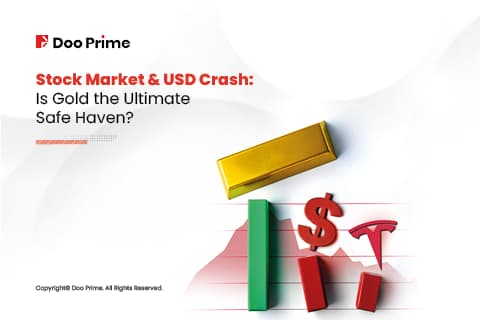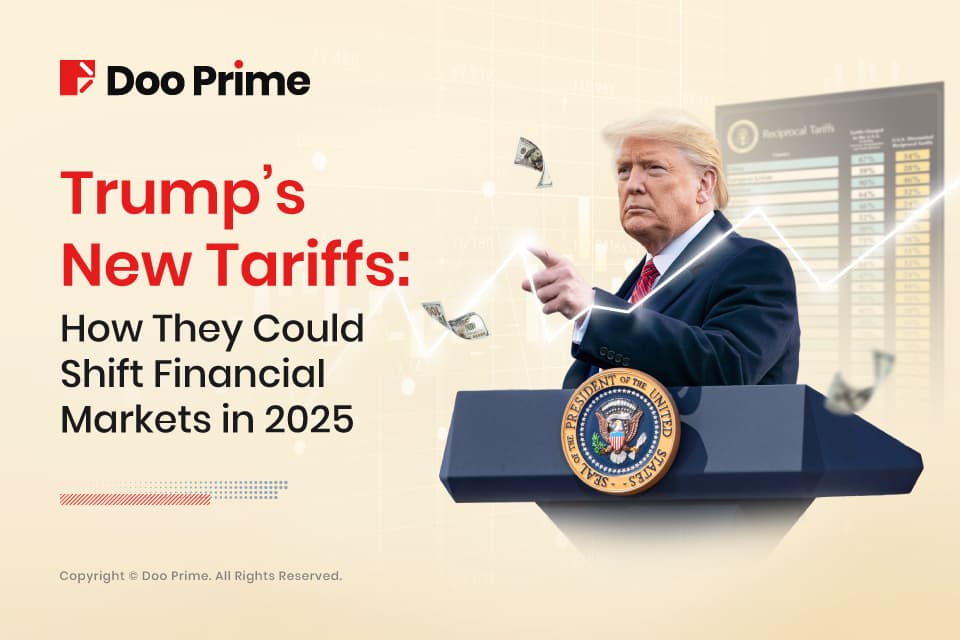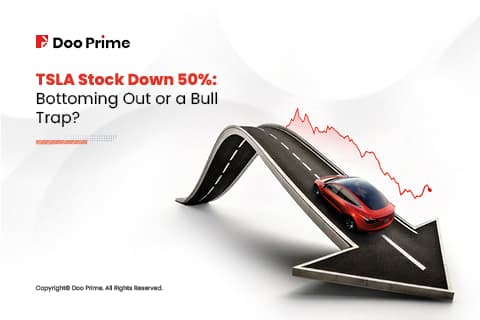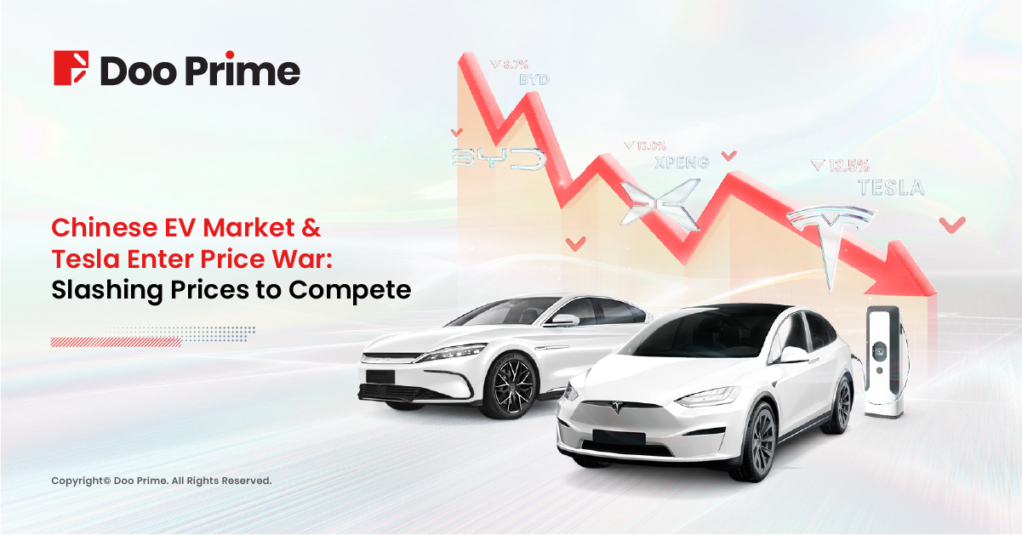
In 2022, the Elon Musk-led carmaker missed its target to grow deliveries by 50% annually as it struggled with supply chain constraints and a demand slowdown caused by growing recession fears.
Still, Musk has said the company could deliver 2 million vehicles in 2023 as price cuts boost demand.
This year, the China-made Tesla car sales rose 18% in January from a five-month low hit in December while February saw a 12.6% rise.
Against this backdrop, Tesla started slashing prices of its electric vehicles in the United States and Europe, doubling down on a discount drive it started in Asia as demand slows against the backdrop of a weakening economy.
The China EV price war has escalated dramatically, sparked by Tesla’s aggressive price cuts, and has now shifted its focus to the mass market. As the world’s largest and fastest-growing EV market, competition is fierce, with domestic players jostling for position alongside new entrants such as Tesla, threatening EV startups like XPeng and others.
Even premium EV makers like Nio and Li Auto are exploring mass-market offerings, hoping to boost volume and profits.
This intensified competition is set to spill over into other markets, such as Europe and Asia, as China exports excess supply, leading to a potential hit on profit margins for some EV makers.
Ultimately, the market is expected to undergo a “survival-of-the-fittest” shakeout, leaving a few dominant players while weaker brands fade away.
In this article, we will examine the ongoing price war in China’s market and discuss the potential impact it may have.
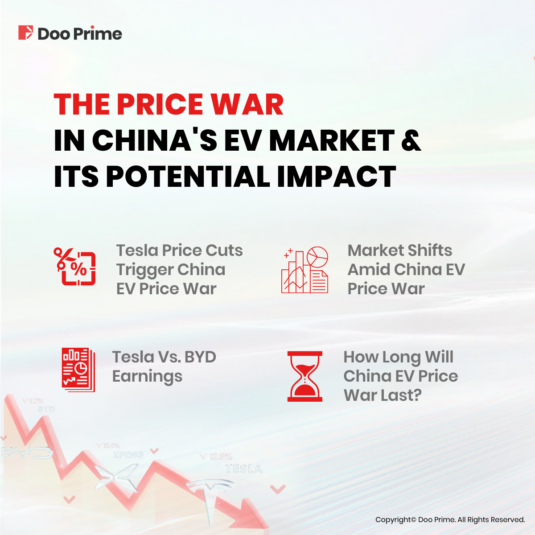
Tesla Price Cuts Trigger China EV Price War
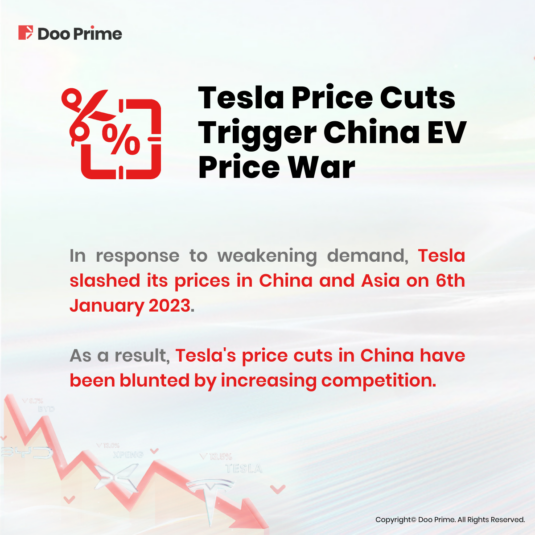
In response to weakening demand, Tesla slashed its prices in China and Asia on 6th January 2023, followed by sweeping cuts in the U.S. and Europe on 13th January 2023. The move made most Model 3 and Model Y vehicles eligible for new U.S. tax credits of up to USD 7,500, subject to various conditions.
As a result of the price cuts, the Tesla Model 3 is now more competitively priced compared to rivals such as the BYD Seal, which starts at RMB 225,800 (USD 32,857). Previously, the Model 3’s China price was roughly USD 10,000 more than the Seal’s.
Although the global price cuts sparked demand for Tesla Model 3 and Y vehicles, there are indications that orders are slumping again, except for the Model Y in the U.S. On 5th March 2023, Tesla cut Model S prices in the U.S. by $5,000 and Model X prices by USD 10,000. A few days earlier, the EV giant cut Model 3 and Y prices across Europe by a further 6%.
In China, however, the impact of Tesla’s discounts has been muted by a slew of rivals slashing prices, including BYD as of late February. Furthermore, many of these companies plan to launch new models in the next few months, directly targeting Tesla.
As a result, Tesla’s price cuts in China have been blunted by increasing competition. Nonetheless, recent sales trends in China have been positive.
Tesla Vs. BYD Earnings
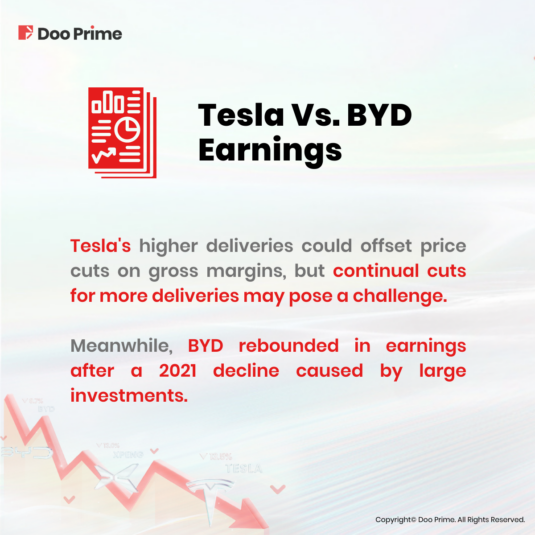
BYD, a mass-market leader in China, has been able to benefit from the introduction of new models and the shift in consumption as the country’s economy slows down. In addition to being China’s EV leader, the company is now the country’s largest automaker. Unlike many of its EV competitors, BYD is profitable and is expected to report nearly five times its 2021 profits in 2022 as sales growth is projected to increase by more than 80%.
With this, let’s compare the earnings of Tesla and BYD – the world’s largest electric-vehicle makers.
In 2021, Tesla’s earnings per share surged to USD 2.26, more than tripling from the previous year’s 75 cents and 2019’s mere 1 cent. Its fourth-quarter earnings increased by 40%, surpassing some analysts’ estimates but falling short of others’. The revenue grew by 37%, marking a robust gain, albeit the slowest, in several quarters.
Despite the strong performance, Tesla’s gross margin dropped to 23.8% in the fourth quarter, compared to 25.1% in the previous quarter and 27.4% in Q4 2022.
Its automotive gross margin also declined from 27.9% in Q3 to 25.9% in Q4, and significantly from 30.6% a year ago. However, it’s worth noting that Tesla doesn’t include R&D expenses and service center overhead in its gross margin calculations, unlike most automakers. If we factor in only the R&D costs, Tesla’s overall gross margin in Q4 would be 20.4%.
Looking ahead, Tesla projects to manufacture 1.8 million vehicles this year, up 37% from the previous year. However, during the earnings call, Elon Musk revealed that the internal target is closer to two million.
While higher deliveries could help offset the impact of the sweeping price cuts on gross margins, continued price cuts for incremental delivery gains could pose a challenge.
Meanwhile, BYD, another electric vehicle maker, saw a rebound in earnings after a drop in 2021 due to massive investments. The company reported a net profit of 16 billion to 17 billion yuan (USD 2.37 billion to USD 2.52 billion) for full-year 2022, a staggering increase of 425% to 458% in local currency terms. This implies a Q4 net profit of 6.7 billion to 7.7 billion yuan (USD 990 million to USD 1.17 billion), a year-over-year surge of 1,013% to 1,179% in local currency.
BYD also anticipates that its annual revenue will exceed 420 billion yuan (USD 62.2 billion), indicating a Q4 revenue of at least 152.3 billion yuan (USD 22.6 billion), suggesting a year-over-year growth of over 115%.
In Q3, the company’s net income skyrocketed by 350% in local currency terms, with revenue increasing by 116%, and adjusted earnings spiking by 923%.
While the company has not disclosed its gross margin for Q4, it likely improved compared to Q3. In the third quarter, BYD’s gross margin was 18.96%, up from 14.39% in Q2 and 13.33% a year earlier. Additionally, its automotive gross margin was 22.77%, up from 17.82% in Q2 and 17.31% a year ago.
Market Shifts Amid China EV Price War
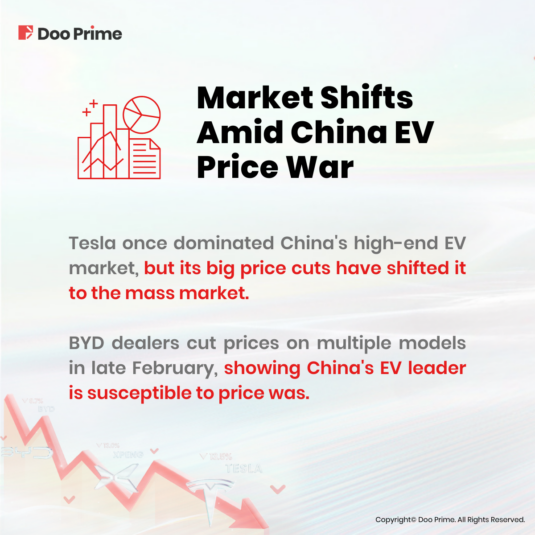
The majority of BYD’s models are priced between 100,000 RMB and 200,000 RMB, which is roughly equivalent to USD 15,000-USD 29,000, and are considered value offerings.
However, the company has expanded into the “affordable luxury” market with newer models like the Seal and Frigate and has aggressively grown its Denza brand to target the premium market.
Additionally, BYD has launched a super-premium brand called Yangwang, with a heavy-duty SUV set to launch in the third quarter, and is planning to launch another “F Brand” between Denza and Yangwang.
Tesla previously dominated China’s premium EV segment, but with its significant price cuts, it has moved from the premium into the mass market, according to Tu Le of Sino Auto Insights, an advisory company.
The Model 3, which was initially priced nearly USD 10,000 higher than the BYD Seal, came down to just USD 600 more after early January, and BYD also offered new Seal discounts in early March. However, there is fierce competition in the sub-300,000 RMB segment, and while BYD continues to dominate there, XPeng is struggling.
In late February, BYD dealers reduced prices on several models, indicating that even China’s EV leader is not immune to the price wars.
How Long Will China EV Price War Last?
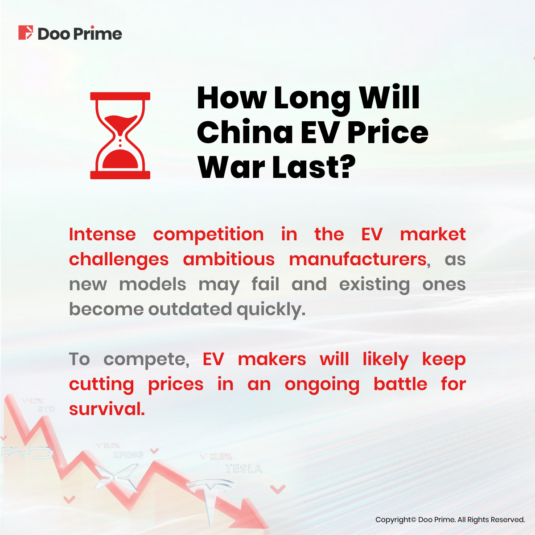
The duration of China’s EV price war remains uncertain as it persists without signs of abating. This competitive climate poses a challenge to many EV manufacturers with ambitious production plans, as the success of new models is unpredictable while existing ones risk rapid obsolescence. To remain competitive, EV makers are expected to continue reducing prices, leading to an ongoing and intense battle for survival.
While exports may offer a potential solution, this approach also carries the risk of spreading the price war to overseas markets. This is evidenced by Tesla’s recent decision to lower prices in Europe, and other Chinese EV manufacturers such as BYD are likely to increase competition in both Europe and Asia.
For foreign OEMs attempting to penetrate the Chinese EV market, the price war presents a significant obstacle, potentially locking them out of the world’s largest auto market. Conversely, Chinese EV manufacturers may gain a greater foothold in Europe as battle-tested models become more prominent.
Despite the ongoing price war, the U.S. market is expected to remain relatively insulated due to existing tariffs and EV tax credit rules. Apart from a few Geely brands, Chinese EV makers have yet to establish a significant presence in the U.S. market.
| About Doo Prime
Our Trading Products
Securities | Futures | Forex | Precious Metals | Commodities | Stock Indices
Doo Prime is an international pre-eminent online broker under Doo Group, which strives to provide professional investors with global CFD trading products in Securities, Futures, Forex, Precious Metals, Commodities, and Stock Indices. At present, Doo Prime is delivering the finest trading experience to more than 90,000 clients, with an average trading volume of more than USD 51.223 billion each month.
Doo Prime entities respectively holds the relevant financial regulatory licenses in Seychelles, Mauritius, and Vanuatu with operation centers in Dallas, Sydney, Singapore, Hong Kong, Dubai, Kuala Lumpur, and other regions.
With robust financial technology infrastructure, well-established partnerships, and an experienced technical team, Doo Prime boasts a safe and secure trading environment, competitive trading costs, as well as deposit and withdrawal methods that support 20+ different currencies. Doo Prime also incorporates 24/7 multilingual customer service and extremely fast trade execution via multiple industry-leading trading terminals such as MT4, MT5, TradingView, and Doo Prime InTrade, covering over 10,000 trading products.
Doo Prime’s vision and mission are to become a financial technology-focused broker, streamlining international global financial products investment.
For more information about Doo Prime, please contact us at:
Phone:
Europe : +44 11 3733 5199
Asia : +852 3704 4241
Asia – Singapore: +65 6011 1415
Asia – China : +86 400 8427 539
E-mail:
Technical Support: [email protected]
Account Manager: [email protected]
Forward-looking Statements
This article contains “forward-looking statements” and may be identified by the use of forward-looking terminology such as “anticipate”, “believe”, “continue”, “could”, “estimate”, “expect”, “hope”, “intend”, “may”, “might”, “plan”, “potential”, “predict”, “should”, or “will”, or other variations thereon or comparable terminology. However, the absence of such terminology does not mean that a statement is not forward-looking. In particular, statements about the expectations, beliefs, plans, objectives, assumptions, future events, or future performance of Doo Prime will be generally assumed as forward-looking statements.
Doo Prime has provided these forward-looking statements based on all current information available to Doo Prime and Doo Prime’s current expectations, assumptions, estimates, and projections. While Doo Prime believes these expectations, assumptions, estimations, and projections are reasonable, these forward-looking statements are only predictions and involve known and unknown risks and uncertainties, many of which are beyond Doo Prime’s control. Such risks and uncertainties may cause results, performance, or achievements materially different from those expressed or implied by the forward-looking statements.
Doo Prime does not provide any representation or warranty on the reliability, accuracy, or completeness of such statements. Doo Prime is not obliged to provide or release any updates or revisions to any forward-looking statements.
Risk Disclosure
Trading in financial instruments involves high risks due to the fluctuation in the value and prices of the underlying financial instruments. Due to the adverse and unpredictable market movements, large losses exceeding the investor’s initial investment could incur within a short period of time. The past performance of a financial instrument is not an indication of its future performance. Investments in certain services should be made on margin or leverage, where relatively small movements in trading prices may have a disproportionately large impact on the client’s investment and client should therefore be prepared to suffer significant losses when using such trading facilities.
Please make sure you read and fully understand the trading risks of the respective financial instrument before engaging in any transaction with Doo Prime’s trading platforms. You should seek independent professional advice if you do not understand any of the risks disclosed by us herein or any risk associated with the trade and investment of financial instruments. Please refer to Doo Prime’s Client Agreement and Risk Disclosure and Acknowledgement Notice to find out more.
Disclaimer
This information is addressed to the general public solely for information purposes and should not be taken as investment advice, recommendation, offer, or solicitation to buy or sell any financial instrument. The information displayed herein has been prepared without any reference or consideration to any particular recipient’s investment objectives or financial situation. Any references to the past performance of a financial instrument, index, or a packaged investment product shall not be taken as a reliable indicator of its future performance. Doo Prime and its holding company, affiliates, subsidiaries, associated companies, partners and their respective employees, make no representation or warranties to the information displayed and shall not be liable for any direct, indirect, special or consequential loss or damages incurred a result of any inaccuracies or incompleteness of the information provided, and any direct or indirect trading risks, profit, or loss arising from any individual’s or client’s investment.

